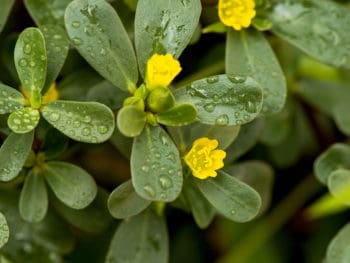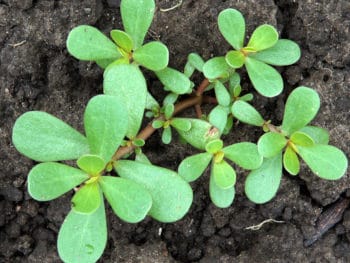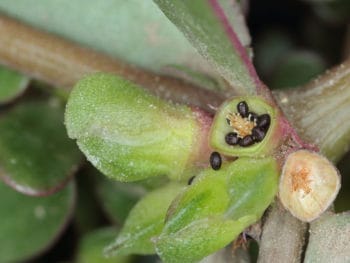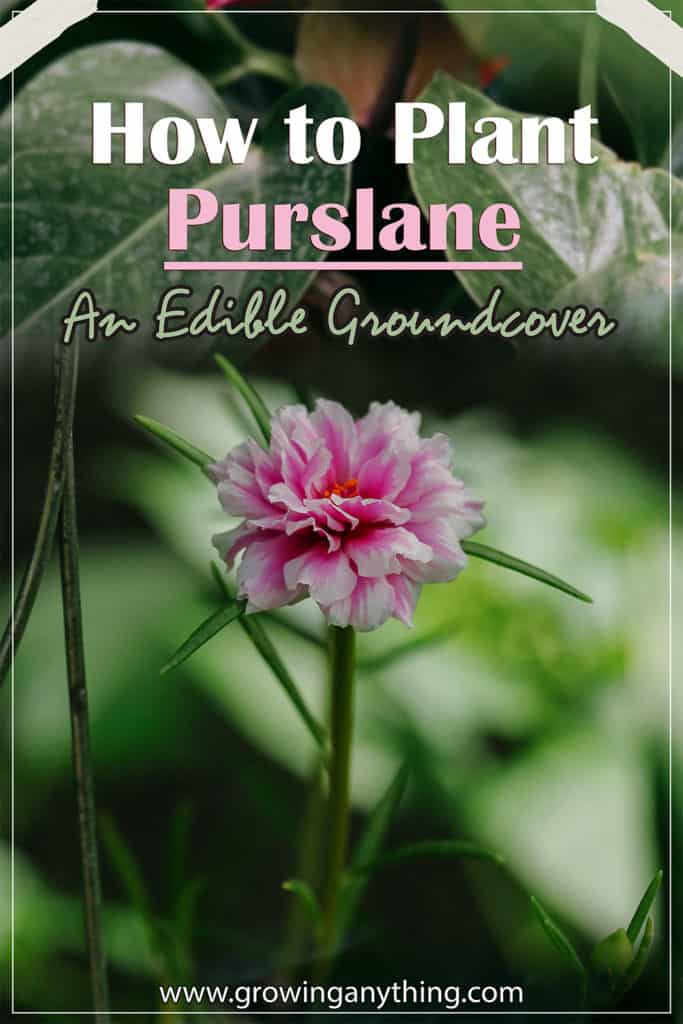How to Plant Purslane
Learning how to plant purslane could be one of the most beneficial things that you can do for yourself. This plant will not only help you make your garden more beautiful, but it will also improve your diet.
What a lot of people do not understand about purslane is that it is much more than just weed. Over the years, research showed that this is one of the most durable, most adaptable plants that is also high in nutrient. To add to that, it is often used in alternative and traditional medicine.
With so many great sides to this plant, purslane might just be the type of plant you need for your garden. Let’s go over the basic facts that you have to know about purslane and how to plant it before you get to it!

Purslane Facts
Purslane is a succulent plant also known under the name Portulaca oleracea. Some of its informal names include duckweed, pursley, verdolagas, pussley, fatweed, and even wild portulaca.
For a long time, it was considered as nothing more than a useless weed. However, once people started to realize that it can be used for medicinal purposes, they started to grow this weed on purpose.
Another reason why people grow this succulent now is because of its nutritional benefits. Purslane is known for containing a lot of minerals, antioxidants, and vitamins. It has more nutritional benefits than some of the vegetables you would use as part of your diet.
Purslane is commonly cultivated in the Mediterranean area, Europe, and also Asia. All the parts of the plant can be eaten and they have been said to have a very intense flavor.
However, the purslane that has been grown on purpose tends to be a bit sweeter in flavor. The leaves on the cultivated purslane are a bit bigger and they grow more upright than the leaves on the wild purslane.
The best time to plant purslane is during the hottest months. This type of plant is known for being drought resistant, which makes it thrive even in hot weather. Also, the plant has enough water stored in the leaves and its stem to use during the warmer dry months.
Purslane Plant Anatomy
The anatomy of this wonderfully beneficial plant consists of three separate parts: the stem, the flowers, and the seeds.
1. Purslane Stems
When planting purslane, one of the most important things that you have to remember is that you should plant it in direct sunlight. The purslane is known to thrive when it has sunlight, it will grow and spread quite quickly while a full shade might keep it underdeveloped for a longer period.
An interesting thing about the stems of this plant is that when cut, they can easily set roots anywhere. If the soil is moist enough and if there is enough sunlight, the plant will start spreading more quickly than anticipated. However, there are still limits when it comes to its growth.
Usually, what can limit the growth of purslane is competition and shade. The temperature in the area where you live will affect the speed of development of the stems. Also, the plant will compete with itself and the surrounding plants in an effort to establish itself. Once it emerges, it will start searching for the best conditions to help it reach its full potential.
2. Purslane Flowers
When the purslane gets to a certain age, its growth will start to decline. It is only at this point that it will start producing flowers. Usually yellow in color and small in size, these flowers open only in full sunlight and are quite short-lived.
As long as the plant grows, the stems will produce new flowers that will then contribute to seed production. Also, I have to mention that newer stems will take longer to grow flowers than the older stems.
3. Purslane Seeds
When the flower is fertilized, it starts producing seeds. The seeds come in a little seedpod that resembles a bird’s nest. They are quite small and black and can be easily spread around by animals, wind, or even rain. It is very easy for the seeds to develop roots in the soil, so eradication of a purslane plant can be almost impossible.
How to Plant Purslane
The process of planting purslane is quite easy and quick. No matter what you start growing it from, the purslane will take root just about anywhere and will do it pretty quickly.
This can often be seen as a problem because purslane tends to grow anywhere and everywhere. It can quickly spread from where you want it to just about everywhere in your garden. But, no need to worry, there are several ways in which you can control its growth.
The first thing that you should do to avoid the purslane from spreading is to stop its seeding. When you see the first seedlings, you need to remove them immediately. If you remove them completely from the soil, they will not find their way back.
However, this goes only for the purslane that you do not want. If you want the purslane to grow, you will be happy to see the seedling coming from the ground.
Usually, people use seeds to propagate purslane. However, you can also use transplants, cuttings, or even divisions to grow the plant. This is because purslane seeds can be hard to find in many countries worldwide.
1. Planting Purslane From Seeds
The best way to grow purslane is by planting seeds. Once you plant purslane, you will never have to worry about it again because the plant itself produces a lot of seeds that encourage the growth of new purslane.
It is best to plant the seeds in early spring and do it in moist soil. The pot or part of the garden where you plant the purslane should be in sunlight and it should not be covered.
If you decide to start growing the purslane in a pot, you will need to eventually transport it to a garden. Keeping the pot away from wind and in sunlight will encourage faster growth. It will take only a few weeks before the first purslane roots come out from the ground.
Let’s see this video to collect more understandings:
2. Planting Purslane From Cuttings
Each stem of the purslane plant can be used to grow a new plant altogether. This can make thing easier for those who want to grow the purslane on purpose, but it makes it a lot tougher for those that are not.
What you need to do with the stem cutting is to make sure that it is at least six inches long. Also, remove all leaves that come from the bottom of the cutting. Once you have that settled, you can start with the actual planting.
Hurry the stem underground and keep it well watered and in sunlight. It should take about a week for the purslane to start growing. Once it starts growing, you can start thinking about transplanting it to your garden.
Let’s see this video to collect more understandings:
3. Planting Purslane by Transplanting

Transplanting purslane can be very easy. The only thing that you need to do is take the purslane from the ground in one piece, with the roots and stems attached. Then, in the new garden, you need to dig a new hole for it.
The hole should be two times larger than the root ball itself. Once you have the hole ready, you can just put the plant in the hole and fill the hole back again. Make sure that you have the root and stem of the plant if you want it to grow.
Let’s see this video to collect more understandings:
Post-Planting Purslane Care
As I have already mentioned, it is best to plant the seeds or stem cuttings in early spring. It will take about ten days for the plant to start growing and about six weeks before you can start harvesting it. There are some things that you can do to make sure that the plant is well taken care of.
1. Temperature
If you want to know when it is best to plant the seeds, you need to make sure that the temperature is around 70°. Also, you can plant the seeds when the daily temperature is from 85° to 90°.
Even though purslane is very low maintenance and adaptable for various temperatures, it does not like temperatures above 90°.
2. Sunlight
This plant needs a lot of sunlight. Whether it is only seeds in a pot or the actual plant in a garden, the purslane will require sunlight during the day to grow. Also, make sure that the plant is never in full shade!
3. Soil Type
The type of soil that a purslane plant requires is one that has some fertilizer and that has good drainage. It is the same type of soil that is used for growing most types of vegetables.
To get the most out of the plant, the soil will need to have a pH starting at 5.5 and up to 7.5. However, the plant will also thrive in regular soil as it is often found growing even on sidewalks.
4. Water
Since this is a succulent, it does not require much water once it starts growing. However, you need to make sure to water it daily during the first few weeks. With that being said, never give it too much water that will waterlog it.
After the germination period, the purslane will need watering only a few times a week. It is best only to dampen the soil instead of giving it too much or too little water. Remember to always avoid overwatering as it can cause problems for the plant’s growth.
5. Pests and Diseases That Might Affects the Purslane
Since it is a very tough plant, the purslane does not face a lot of issues when it comes to pests or diseases. However, there are some things that you should be careful about.
For example, some leaf-mining larvae might attack the plant. If that is the case with your plant, then you will need to remove them by hand or use parasitic wasps to drive them away. As for some other types of pests, you can use insecticide at night to clear them up.
Purslane can also be affected by fungus, which usually happens in a moist climate or when overwatering the plant. If you have such a problem, you can use neem oil or some fungicide to stop the fungus from spreading.
Harvesting Purslane
It takes nearly 50 days from the time you plant the seeds for the purslane plant to be fully matured. Once it has matured, the thing that you need to do is harvest it.
Get yourself a pair of sharp scissors that have been thoroughly cleaned and disinfected. Take into consideration when you will do the harvesting as the plant is known for having different tastes in different parts of the day. If you cut it in the morning it will have a tarter taste, while if you do it in the afternoon it will have a sweeter taste.
When you harvest the purslane, going leaf by leaf will take way too long because the leaves are way too small. It would be best to cut the entire stem with the leaves because the stem contains a lot of nutrients as well. Another thing to look out for is leaving at least two inches of the plant above ground when you do the cutting. That will make it easier for the plant to regrow.
Difference Between Wild and Cultivated Purslane
Before you start harvesting purslane, you need to be aware of the differences between wild and cultivated purslane. There is a very similar plant that looks like purslane but is poisonous.
You can differentiate the poisonous and cultivated purslane by their stems. When you harvest the poisonous one, a milky sab will come out of the stem. If you see this happen, you should know that the purslane is poisonous, and under no circumstances are you to eat it.
As for the cultivated purslane that does not contain this milky sab, it is completely safe for eating and you should consider adding it to some of your meals.
What Can You Use Purslane For?

Once you have harvested the mature purslane that you planted and grew yourself, there is a couple of things that you can do with it.
First, you need to find how to preserve it because the purslane will wilt quite quickly after it has been harvested. If you are planning on using it for something instead of throwing it away, you should wrap it in a plastic bag or a cotton cloth and put it in the refrigerator. Keep in mind that purslane can last longer if you do not wash it before you refrigerate it.
Another thing that you can do with the purslane is that you have dry it up and use it in meals or desserts. You can also add it as an herb while baking or turn it into smoothie powder.
The reason why you should keep the purslane and use it is that there are so many benefits to it. As I have already mentioned, it is growingly popular because of its nutrition. It is rich in healthy omega-3 fats, magnesium, vitamins A and C, as well as potassium and iron.
You can easily google some recipes in which you can use purslane and you will find anything from soups to purslane bread and deserts. The purslane salads are also very delicious, so make sure to try them as well.
As for the other reason why you should use purslane, it is because of its medicinal benefits. It has been said that purslane can help with uterine bleeding, so people with diabetes can benefit from it. Also, it has been often used in asthma treatments and anti-inflammatory medicine.
Some women have found that mixing the purslane leaves with olive oil can help with skin irritation both during summer and winter. So, the cosmetic industry might start looking into using this plant in their products soon!
Conclusion
Many vegetables and herbs can be easily grown, but the top stop on the list is always reserved for purslane. It requires no maintenance, but it has so many benefits for people. These are only some of the reasons why you should consider adding it to your garden.
After reading my article on how to plant purslane and what the benefits from it are, you will never again see it as just some weeds growing in your yard. If you have tried doing something with purslane, whether it is food or remedies, make sure to share it with me in the comments below!

